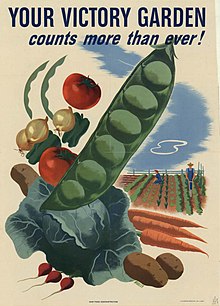Victory garden

Victory gardens, also called war gardens or food gardens for defense, were vegetable, fruit and herb gardens planted at private residences in United States, United Kingdom, Canada and Germany[1] during World War I and World War II to reduce the pressure on the public food supply brought on by the war effort. In addition to indirectly aiding the war effort these gardens were also considered a civil "morale booster" — in that gardeners could feel empowered by their contribution of labor and rewarded by the produce grown. Making victory gardens became a part of daily life on the home front.
Background
These Victory Gardens meant a lot to the war effort and were a big part of war on the home front.
Films
The United States Department of Agriculture issued a 20 minute film to promote and train people how to plant victory titled Victory Garden.
TV show
The successful WGBH public television series The Victory Garden, given wide distribution in the U.S. over the Public Broadcasting Service, took the familiar expression to promote composting and intensive cropping for homeowners who wanted to raise some vegetables (and some flowers). It has continued for over three decades. .......
See also
- Rationing in the United Kingdom during and after World War II
- Land Army
- Allotment (gardening)
- Home front during World War II
- United States home front during World War II
References
Notes
- ^ Victory gardens Australian War Memorial encylopedia
Bibliography
External links
- PBS: The Victory Garden
- A history of Victory Gardening
- Victory Gardens Handbook of the Victory Garden Committee War Services, Pennslvania State Council of Defense (April 1944)
- Victory Garden complete film at archive.org
- History of Urban Gardening in the United States
- GARDENS FOR VICTORY reference pubbed Mar. 1942, intro/first chapter
- Revive the Victory Garden
